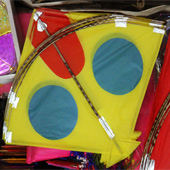Design Resource
Kite Making - Gujarat
Paper Kites for Uttarrayan Festival
by
Prof. Bibhudutta Baral, Divyadarshan C. S., Abhishek G. and Lija M. G.
Paper Kite Making:
The kite papers used in making kites are purchased from Delhi, locally known as “Thirveni”, are very light weighted. One bundle of kite paper consists of 190 sheets.
Stencils made of cardboard piece, shaped as kite is used to get the proper measurement to make a kite. These stencils come in different shapes and sizes. Measurements are made on the sheet using stencils and the kite paper is cut using scissors into required shape and size.
After the kite paper is cut into required shape and size, thin cotton thread is pasted on the sides to avoid the paper from tearing or to prevent it from getting torn while flying the kite. The craft paper is diagonally folded into two equal halves. The designs patterns are made using different colorful papers separately and pasted on these craft papers.
Bamboo stick is then pasted diagonally which supports and strengthen at end of the corners. Bamboo sticks are bought from Calcutta and Assam and sold in the local market. These bamboo sticks are heated on to create design pattern on them. Gum made of Maida flour is used to paste bamboo sticks on the kite.
The stick which is pasted straight is known as “Tadda” and the one which is pasted in an arc is known as “Kammaan”. Tail of the kite is called as ghesiya or poonch. A small piece of paper which is used to stick the sides of the kite is called as Chippa or Patti.
Three people are involved to make one kite. One artisan cuts the required shape of the kite and the other pastes bamboo sticks on the kite. And the third artisan pastes patti and adds tail to the kite. More than two thousand kites are made in a day.
Plastic Kite Making:
Plastic kites are produced in equal quantity as paper kites. The plastic kites are made from waste plastic sheet which is purchased from the manufacturing company’s waste department. The sheets are cut into required shape using stencils. Bamboo sticks are fixed on the cut plastic sheet using chemical adhesive. Sides of sheets are curled and pasted on the bamboo stick. The sides of the bamboo are locked by pasting pieces. Coloured cello tapes are fixed on the sides of the kite to secure the bamboo sticks from coming off. Tail is added in the bottom to make it look attractive. The purchased plastic sheets are uneven in size and shape as they are wastes, this the reason that plastic kites are always made in small size. Plastic kites are less expensive and more durable compared to paper kites.


























